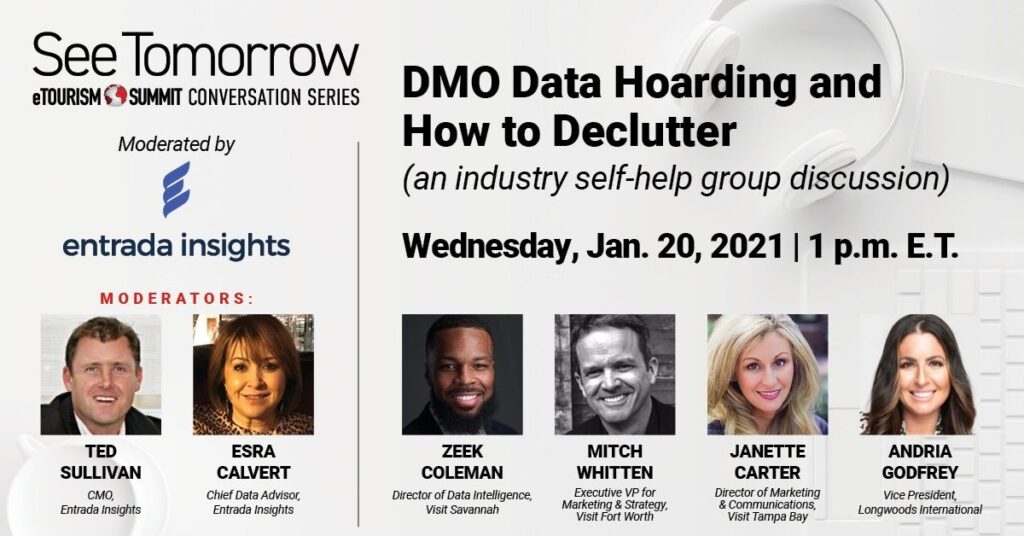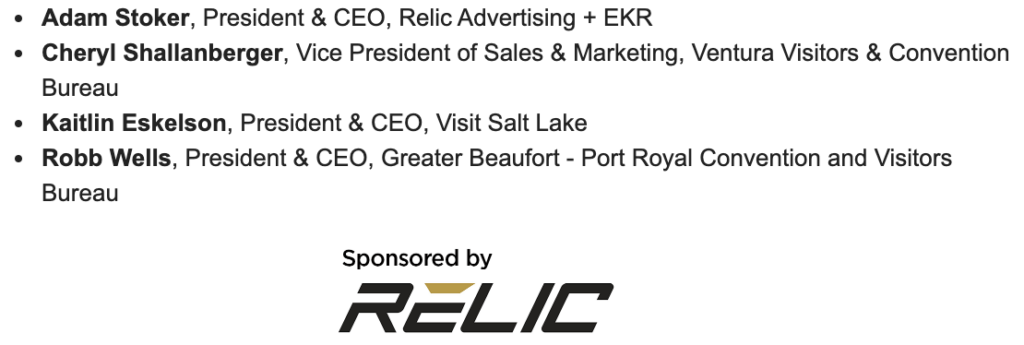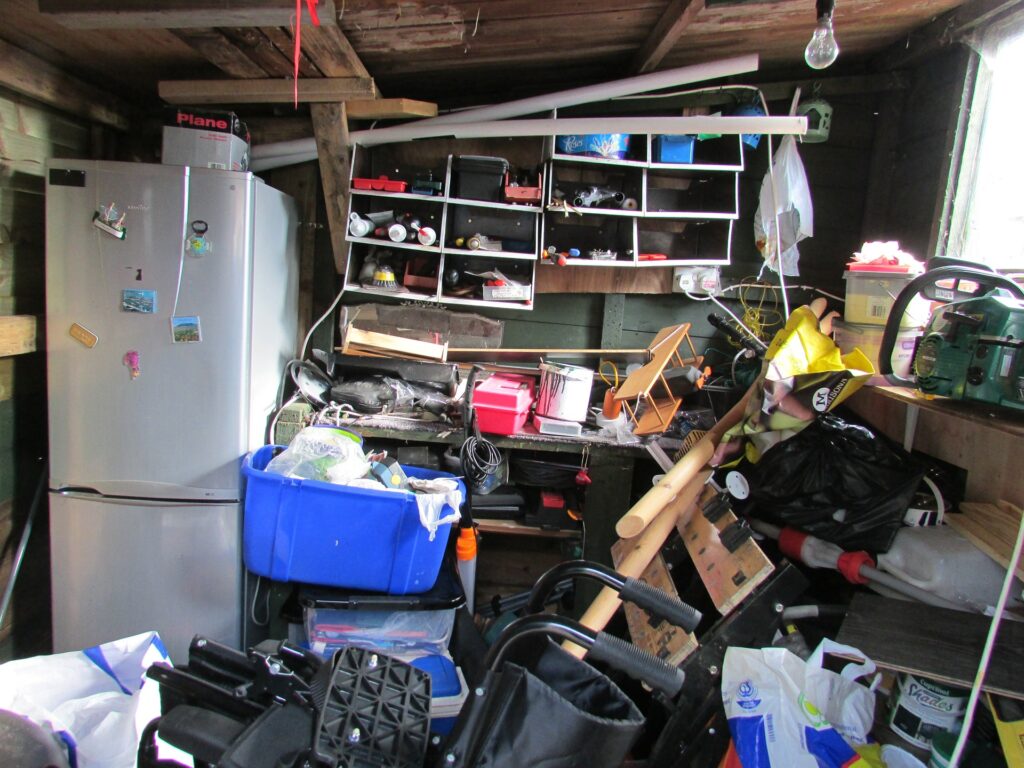Takeaways and tips from the first “See Tomorrow” conversation series…you won’t want to shove these to the back of the closet.
“Clutter is not just physical stuff. It’s also old ideas, toxic relationships, and bad habits. Clutter is anything that does not support your better self. ” — Eleanor Brownn
Supported by an expert panel of DMO tourism data geeks and marketers, Ted Sullivan and Esra Calvert from Entrada Insights fielded questions about decluttering the monster that is research and data. Responses are summarized; some are tagged.

Q: How many do you have coming into your DMO? How many do you think you really need?
Two dozen, perhaps? It’s difficult to determine what’s truly important, but quite a lot should be thrown out: vanity metrics, pixel tracking, duplicate data sets, summaries that are dated before you get them.
Importantly, make sure your data is answering your key questions, such as: Who are my top audiences? Where do they come from? What do they like to do? Did we reach them? How can we improve on their experience?
Q: Like cleaning out your closet…Name two data streams you’d like to get rid of and two you’d like to add.
No data is singular. Correlation doesn’t equal causation, so we benefit from triangulation of data points. It’s not really about having the “right number.” It’s about establishing what you need to plan your marketing strategy and what you need to share with stakeholders. (Zeek)
Within a DMO, data suits different departments, so it’s useful to layer these needs. Talking among ourselves about STR data, for example, can lead to better insights. What has changed? rid of old Covid numbers and data. Let’s add tools that help with spending. The surprise may be that email open rates still provide useful information when we communicate with locals. (Mitch)
Bookings are now more pertinent than brand awareness and website analytics. Top priority is to definitely keep data that supports economic impact. (Janette)
And, resident sentiment research is essential. Because people are evaluating destinations in different ways now, image research is very interesting. (Andria)
Q: What DMO’s data and marketing strategy do you admire most?
I like bouncing things off Lauren Phillips at Visit Fort Worth. But when I explore new ideas with vendors, I typically find out that Leroy Bridges at Clearwater St Pete CVB had already had that conversation, so he’s “a mystery to me.” (Zeek)
Destination Canada is a thought leader. (Mitch)
Visit Florida and other west coast Florida DMOs. (Janette)
At Longwoods International, we work with 150 DMOs, so it’s a broad viewpoint. Generally, having long-term and short-term goals in mind at the same time, all the time is a critical skill. We must not just see the year-end summary report like it’s a Christmas present. (Andria)
Q: With so much data available daily, how much time is too long to even be relevant to your destination? With so much, how do you balance timelines and relevance? Is there a mix that makes sense?
Time is precious and our resources are fewer than ever. Cleaning the data, inputting, referencing, juggling spreadsheets, managing the shelf-life is a time sink but it’s a “whole job”— a critical task.
Q: If marketing is now focusing on behaviors more than demographics, which data is now just clutter or irrelevant to your efforts?
Our post-Covid understandings now go beyond “the road trip.” Drive market is on the chopping block. We need to focus on the ‘why.’ What do they like; why are they coming here? (Mitch)
Data should serve goals, not the other way around. Bring your summary data to your meetings so it can inform strategy. (Mitch)
We look at separating short-term metrics from that which has legs. (Janette)
Q: Travel decisions are now emotional to our visitors. Is data that looks at the past still relevant or has it become clutter for your organization?
Metaphorically speaking, how do we get people to buy this box of cereal, not that one? (Andria)
Business, meetings, and events will come back; set long-term goals with that in mind. Look at PR (Cision Insights) and social media as a resource that’s timely and can fill in gaps on smaller trends between larger scale reporting. (Mitch)
Q: What is your data addiction? What can you not get rid of?
Anonymized location-based data is “creepy but sensational.” (Zeek)
In-market spending and out-of-state credit card spending.
Interactive crosstab tool in Longwoods International products.
Addicted to PR stats to help build and tell our stories, allow people to see themselves fitting into those stories that resonate with the community and with visitors.
Data that informs likelihood to travel at the top of the funnel.
Keep the statistics that support your KPIs to help prove your existence. (Janette)
Data should serve goals, not the other way around. Bring your summary data to your meetings so it can inform strategy. (Mitch)
Q: What do you recommend to DMO hoarding addicts?
Set a goal and let the data support the goal, not vice versa.
Build an internal team to clean, categorize the data.
Evolve. Use tech. Let the old stuff go.
Bring your stakeholders — including residents — into your communications.
Buy a whiteboard. Ideate. Erase. And ideate some more.

SAVE THE DATE & REGISTER for the next “See Tomorrow” Conversation — Wednesday, Feb. 10 at 1 p.m. ET — “See the Forest AND the Trees: Top Learnings From 2020 as Guideposts for 2021.”



Leave a Reply